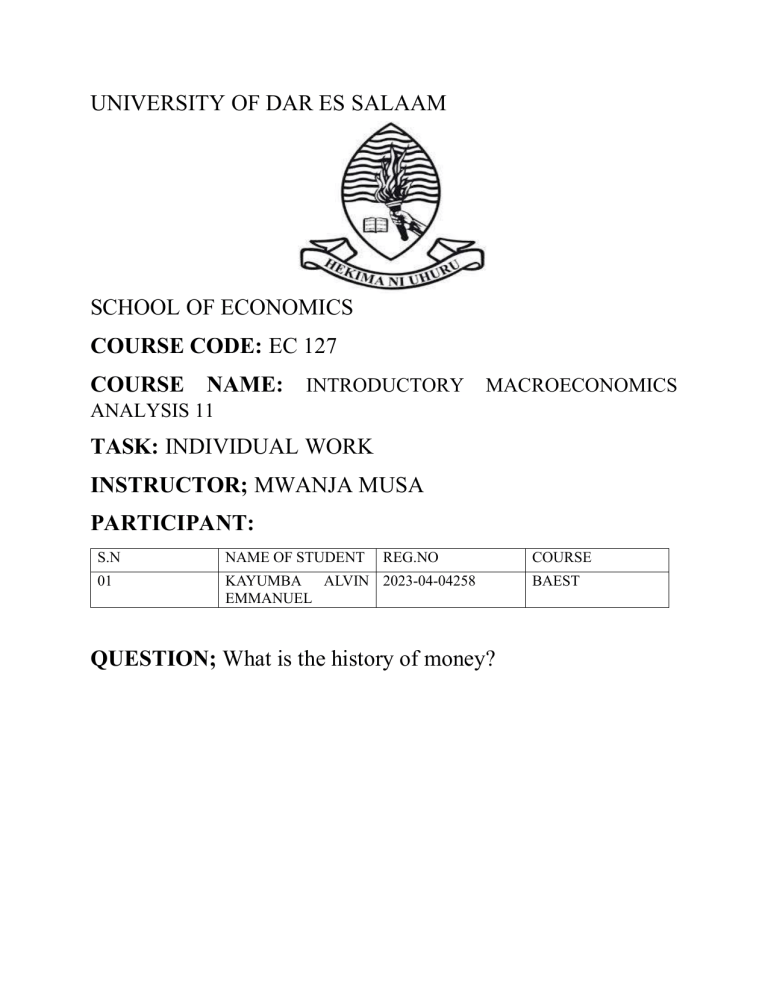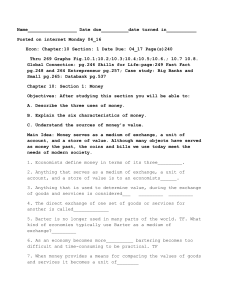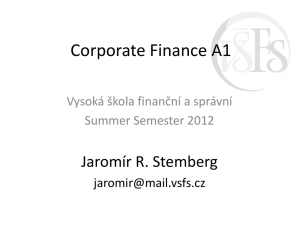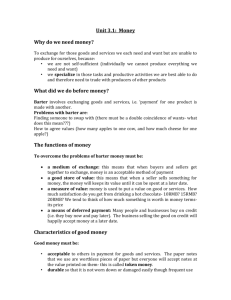
UNIVERSITY OF DAR ES SALAAM SCHOOL OF ECONOMICS COURSE CODE: EC 127 COURSE NAME: INTRODUCTORY MACROECONOMICS ANALYSIS 11 TASK: INDIVIDUAL WORK INSTRUCTOR; MWANJA MUSA PARTICIPANT: S.N NAME OF STUDENT REG.NO 01 KAYUMBA ALVIN 2023-04-04258 EMMANUEL QUESTION; What is the history of money? COURSE BAEST Money is a medium of exchange that is centralized, generally accepted, recognized and facilitates transaction of goods and services, or is the stock of assets that can be readily used to make transactions. For example, the dollars or pounds or yen and Tanzanian shillings in different parts of the world, which may take a physical form as in coins and notes, or may exist in written or electronic account. Money has three functions which are to store value, a unit of account and a medium of exchange. The types of money are of many forms such as, Fiat money is the money that has no intrinsic value because it is established by the government decree, or fiat which only have nominal value another is, Commodity money which can be legally exchangeable for something with intrinsic value such as gold, this gold can be used as money because it can be used for various purposes such as jewelry, dental fillings and so on as well as for transactions, others types are Fiduciary money which is the money on trust or promise and, Commercial money is the money on credit and loans. The History of money is the development over time of systems for exchange, storage and measurement of wealth. Money is a means of fulfilling these functions indirectly and in general rather than directly, as with barter. Money was invented before the history began, based on conjecture and logical inference. The original name of money was “Moneta” which was named by the Roman goddess Juno in the 14th Century. A significant amount of evidence establishes that many things were traded in ancient markets that could be described as a medium of exchange, this included livestock and grain or attractive items such as cowrie shells or beads. Also various metals, both common and precious metals were also used in both barter systems and monetary systems and the historical use of metals provides some of the clearest illusions of how barter systems gave way to monetary systems, such as the use of bronze. Therefore, the following is the history of the money throughout the ages. 1000BC-400AD, this period emerged the use of commodity money, of the objects which had intrinsic value whereas the money was inform of small knives and spades made of bronze was in used in China during the Zhou dynasty, with cast bronze replicas of cowrie shells in use before this. The first manufactured actual coins seem to have appeared separately in India, China and the cities around Aegean Sea 7th Century BC. All modern coins, in turn, are descended from the coins that appear to have been invented in the Kingdom of Lydia in Asia Minor somewhere around 7th Century BC and spread throughout Greece. 400-1450, this period emerged the actual coins and the first paper money, whereas back in 800AD, there was an issuance of standard coin, the silver penny. Between 794 and 1200 the only denomination of coin in Western Europe. During this period of time there was also an introduction of paper money which it was first introduced in Song dynasty during the 11 th Century, as the merchants and wholesalers desired to avoid the heavy bulk of copper coinage in large commercial transactions. The song government had run out of copper to strike new coins, and such issued the first generally circulating notes named “Jiaozi” which did not replace the coins but was used alongside wit it. 1450-1971, This period emerged the lending of money, and money stored in the bank whereas the scriveners were the first to keep deposits for the express purpose of relending them. Promissory notes were issued for money deposited, which by custom was loan to the goldsmiths. The First European banknotes were issued by Stockholms Banco, a predecessor of Sweden’s central bank Sveriges Riksbank in 1661. These replaced the copper plates being used instead as a means of payment. Generally, these banknotes were a form of representative money which could be converted into gold or silver by application at the bank. Since, banks issued notes far in excess of the gold and silver they kept on deposit, sudden loss of public confidence in bank could precipitate mass redemption of bank notes and result in bankruptcy. 1971-Present, this emerged the use of payment cards, digital currencies, cryptocurrencies, where as in 1971, the US President Richard Nixon announced that the US dollar would not be directly converted to gold anymore. This measure effectively destroyed the Bretton Woods System by removing one of its key components, in what came to be Nixon shock. Therefore, now international, national and local money is dominated by virtual credit rather than real bullion. In the late 20th Century, payment cards such as credit cards and debit cards became the dominant mode of consumer payment in the First World. The Bankamericard, launched in 1958, became the first third-party credit card to acquire widespread use and to be accepted in shops and stores, soon followed by MasterCard and American Express. Digital currencies are the development of computer technology in the second part that allowed money to be represented digitally. By 1990 all the money transferred between its central bank and commercial banks was in electronic form. Whereas, the current form of money is the Bitcoin, where as in 2008 it was proposed by an unknown author under the pseudonym of Satoshi Nakamoto. Its use of cryptography allowed the currencies to have a trustless, non-fungible and tamper resistant distributed ledger called a block chain. It was widely used decentralized, peer-to-peer, cryptocurrency. The protocol proposed by Nakamoto solved what is known as the double spending problem without the need of a trusted third-party. To conclude, the history of money reflects humanity’s quest for a reliable medium of exchange. From barter to digital currencies, each evolution has been a response to the need of more efficient economic transactions. Money has transformed from tangible goods to abstract numbers, yet its fundamental purpose remains unchanged which are, to facilitate trade, measure value, and store wealth. This journey mirrors the broader story of human civilization, showcasing our innovative spirit and adaptability. Understanding these key developments provides a solid foundation for grasping the complex nature of financial systems today.


